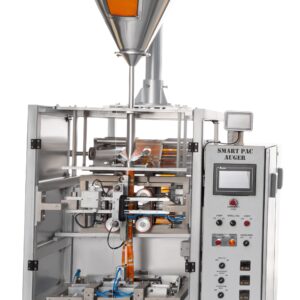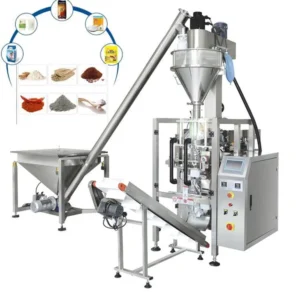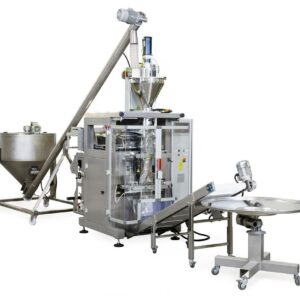Description
| Specification | Details |
|---|---|
| Model | MP-1000 |
| Capacity | Up to 1000 grams per pack |
| Packaging Material | Heat-sealable laminated film |
| Packing Speed | 20-50 packs per minute |
| Power Supply | 220V/50Hz, 1-phase |
| Power Consumption | 3 kW |
| Air Pressure | 0.6 MPa |
| Air Consumption | 0.3 m³/min |
| Dimensions (LxWxH) | 1200mm x 800mm x 1800mm |
| Weight | 500 kg |
| Control System | PLC control system with touchscreen |
| Packaging Accuracy | ±0.2% |
| Suitable Product | Milk powder, coffee powder, etc. |
| Optional Features | Date coder, nitrogen flushing system |
The dairy sector is a vital element of global food production, providing nutrition for millions of people across the world. Milk powder is central in this industry due to its long shelf life, ease of storage, and versatility in various food applications. As consumers’ tastes change over time, there is a need for efficient and hygienic packaging solutions. Milk powder packing machines play a significant role in fulfilling these requirements by automating the process of packaging, thereby ensuring that it is done accurately, consistently, and safely.
Types of Milk Powder Packing Machines
Milk powder packing machines come in different types that meet particular production needs and packaging preferences.
- Vertical Form Fill Seal (VFFS) Machines: VFFS machines are widely used in the dairy industry because they help with forming, filling, and sealing packets vertically fast enough. A roll of packaging material that forms into a bag that will be filled with milk powder before being sealed to form a complete packet is what these machines use. VFFS machines are ideal for high-speed production lines as well as having flexibility in terms of package design or customization.
- Horizontal Form Fill Seal (HFFS) Machines: In contrast to VFFS machines, HFFS ones make their packets horizontally during formation filling and sealing processes. These devices can be easily integrated into existing lines; hence they are favored by industries since they may have several products under one roof such as milk powders among others.
- Pre-made Pouch Packing Machines: Pre-made pouch filling and sealing machines exist specifically for filling and sealing pre-made pouches with milk powder. These devices can be used to pack small, and medium quantity batches since they offer flexible sizes for different types/weights/packaging styles of containers too much so that even if you’re using diverse packages you’ll still acquire favorable results at fewer setup periods when compared to others available out there today most importantly meaning that anyone who has got versatile packaging needs would be at an advantage by choosing them.
Working Process of Milk Powder Packing Machine
The working process for a milk powder packing machine usually comprises several stages, each of which is important in ensuring that the packed product is of good quality and remains intact.
- Feeding and Dosing: Milk powder is put into the hopper of this machine where it is fed into the machine to weigh up accurate quantities. Depending on the type of device, dosing can be done using auger fillers, volumetric cups, or combination weighers. It is imperative to accurately measure to keep consistency in product quality and adherence to regulations.
- Bag Forming: The packaging material, often a film roll, enters the machine where it forms the desired bag shape. For VFFS machines, this happens vertically while HFFS ones will do it horizontally. These formed bags are moved to a filling station for the next step in the packaging process.
- Filling: After forming bags have been made they are filled with a measured amount of milk powder within them using a dosing system that dispenses accurate levels into each pouch thereby minimizing waste caused by imprecision in filling up sacks depending mainly on gravity flow; auger filling or pneumatic conveying systems may also be applied depending upon specific requirements and/or design configurations employed by particular equipment models here during actual feeder operation itself etc..
- Sealing: To close off these packets from getting contaminated as well as preserve their freshness sealing could be done either through heat (in case you want something which doesn’t allow air inside but keeps content safe); ultrasonic used along zippers (to cover all sides including tops and bottoms), zip locks – this is dependent wholly upon nature or kind of materials being used what purpose shall serve like example if someone were looking forward using plastic wraps then they should go over an alternative method known as heat-seal instead whereas those who like handling glass jars would prefer usage of adhesive strips onto their covers etc..
- Cutting and Labeling: After sealing, they are then cut away from the packing material. The process is either an integral part of the sealing station or a separate step that some machines may have. Moreover, tags can be used to brand the bags and contain vital product information such as ingredients, nutrition facts, and expiry dates.
Applications of Milk Powder Packing Machines
The milk powder packing machines are used in various fields within the food and beverage industry including;
- Dairy Industry: Mostly, in dairy industries, milk powder packing machines are utilized for packaging powdered milk products like infant formula, skimmed milk powder, whole milk powder, and specialty milk powders among other brands. These devices make certain that powdered milk retains its quality and nutritional value while it is being hygienically packed.
- Food Industry: Milk powder packing machines play significant roles in providing packages for powdered components which are used in making baking mixes, beverages, snacks, etc., in food companies. This eventually helps manufacturing companies package up accurately and efficiently every time they do it hence preserving their reputation by maintaining consistency and high standards of their products.
- Pharmaceutical Industry: In pharmaceutical sector also utilizes these types of bagging machines for powdered drugs as well as supplements like vitamins or dietary supplements such as protein powders et cetera. Thus ensuring packaging in a sterile environment is required by regulatory bodies hence the safe handling of powdered drugs by consumers.
- Hospitality Sector: Hotels use these machines to put single servings of coffee creamer or tea creamer into packets within this sector. As a result, hotels can give customers clean servings with controlled doses inside measured sachets.
Functions of Milk Powder Packing Machines
Several important functions performed by milk powder packing machines contribute towards the efficiency, quality, and safety of the packaging process;
- Accurate Dosing: Precision dosing systems employed in the operation of milk powder packing machines make it possible to accurately measure out specific amounts (weights) into each package at hand so that no amount is wasted or overfilled. This results in filling machines with consistent fill levels and reducing waste thereby facilitating production efficiency.
- Hygienic Packaging: Food packaging requires a great deal of hygiene, particularly in the dairy sector which is concerned with product safety. In this case, milk powder packing machines are equipped with such sanitary options as flat surfaces, easy-to-clean elements, and hermetic sealing solutions hence preventing infiltration of foreign substances into the packed powder products.
- Efficiency: Milk powder packing machines increase production output and enhance their efficiency through the automation of the packaging process itself. These machines may fill and close hundreds or thousands of bags per hour hence reducing labour cost by minimizing manual processes involved in the production system.
- Versatility: In addition to accommodating various market demands (such as single-serve sachets, stand-up pouches, or bulk packages), milk powder packing machines can also provide versatility in terms of packaging formats, sizes, and designs among other factors considered by manufacturers before making decisions on what type should be used for their products.
- Product Preservation: Proper packaging plays an imperative role in maintaining the quality and shelf life of powdered milk products; thus ensuring their consumability much later after their purchase or production date. To protect against moisture attack from the outside environment, thus promoting stability as well as integrity when handling it over long time durations.
Roles and Advantages of Milk Powder Packing Machines
Automation of Packaging Process: The packaging process is automated by milk powder packaging machines, thus reducing the reliance on human effort and making production operations more effective and efficient. These machines are capable of carrying out such tasks as filling, sealing, and tagging among others at one go which not only increases efficiency but also saves time that could be used in other activities in a factory thereby promoting growth.
Precision and Accuracy: One of the main roles of milk powder packing machines is accurate dosing and filling of powdered milk into containers. Dosing systems built into these machines have been calibrated to give out exact quantities of milk powder required for each bag/ box thus avoiding wastage while producing at optimum levels.
Hygienic Packaging Standards: In contrast, utmost hygienic conditions must be upheld when packing dairy products to avoid contamination that may affect the final product’s health quality. The sanitary aspects incorporated in the design features include smooth finishes that do not allow dirt to stick on it, simple cleaning parts among many others plus airtight seals helping to prevent any external microbial attack during handling.
Product Preservation and Shelf Life Extension: The proper packaging method helps preserve its freshness and shelf life for longer periods. Milk powder packing machines encapsulate the powdered contents within air-tight packages hence keeping away moisture, oxygen, light, or any other form of pollution from affecting it negatively over time thereby ensuring flavor retention and nutritional stability in these products throughout their entire shelf lives.
Customization and Branding: Furthermore, there is flexibility with regards to how manufacturers can customize their brand images using milk powder packing machines which enables them to create unique labeling designs to promote their brands. As part of this strategy therefore logos including graphics or even information about these goods would appear on their covers improving visibility for product identification even as customers choose them over competitors’ goods leading to increased sales volumes mostly because perceived value has risen due to greater demand levels resulting competitive advantage within markets served.
FAQs
What is the typical production capacity of a milk powder packing machine?
Production outputs by these milk powder packaging machines may vary depending on factors like types, sizes, and configurations. Some highly mechanized models can pack thousands of sachets in an hour while others have smaller production capacities.
Can milk powder packing machines accommodate different packaging materials?
Yes, different types of packaging materials such as laminates, polyethylene, polypropylene, and paper-based laminates are handled by milk powder packing machines. The right choice of packaging material for any product is based on product specifications and the market preferences of consumers.
How do milk powder packing machines ensure accurate dosing of powdered milk?
When dosing this type of ingredient into the bags or boxes, one way that it is done properly with high precision is through the use of precise dosing systems such as auger filling devices, volumetric cup fillers, or combination weighments which can achieve this goal consistently. Product wastage is reduced due to accurate fills thus leading to efficient utilization during production.
Are milk powder packing machines suitable for small-scale production operations?
Yes, there are compact-size versions available for small to medium-scale producers when it comes to manufacturing powdered milk products. They provide cost-effective methods of packaging that satisfy varying client desires thereby making them ideal choices for low-capacity producers in the industry.
What safety features are integrated into milk powder packing machines?
For instance, potential dangers highlighted on these systems include malfunction alarms/indicators, emergency stop buttons with red color detergents among others, and guards mounted around most moving parts to ensure operator security.
Can milk powder packing machines handle powdered products with varying densities?
That’s true. Depending upon nature such as thickened fruit juices or dietary supplements made from dry powders having different flow properties will be well taken care of without a hitch by some specific granule dispensers/computerized scales integrated herein because they all guarantee accuracy within their respective ranges.
What is the way milk powder packing machines can maintain hygienic packaging standards?
To ensure that contamination does not occur, milk powder packing machines are designed with sanitary features like smooth surfaces on components that are easy to clean and hermetic sealing mechanisms. Throughout the process of packaging, these machines minimize any possible exposure to foreign contaminants and keep the product hygienic.
Do you find milk powder packing machines easy to operate and maintain?
Indeed, most of the milk powder packing machines have been made in a manner that enables them to be easily operated by users with minimal training. This includes tasks such as cleaning and lubrication as outlined in the manufacturer’s manual to achieve smooth running of the machine over an extended period.
Are there customization options like branding and labeling on milk powder packing machines?
Yes, including branding capabilities for logo printing and labeling facilities, milk powder packing machines offer their customers customization choices. To boost brand visibility among consumers or attract buyers, manufacturers may include their logos, graphics, or product information on the package.
Which aspects should one consider when selecting a milk powder packing machine?
Manufacturers should consider production capacity, compatibility with packaging materials, dosing accuracy; space requirements; budget constraints; and after-sales support provided by either manufacturers or suppliers when picking a suitable milk powder packaging machine. Moreover, it would also be imperative for one to assess whether it complies with regulatory requirements besides industry standards for quality purposes.





